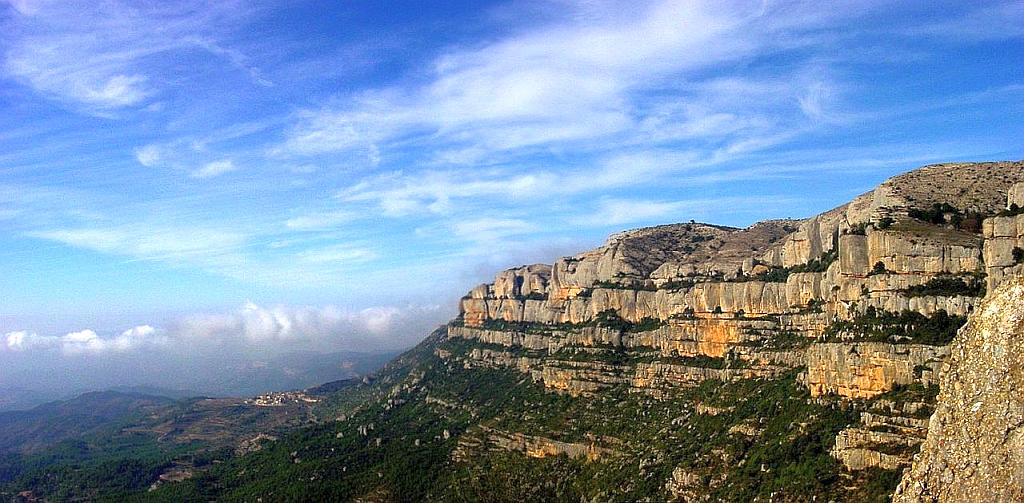- Region: Catalunya
- Province: Tarragona
- Declared a Natural Park: 2002
- Park surface area: 11,755 hectares
- Towns and villages: Cabacés, Cornudella de Montsant, La Bisbal de Falset, La Figuera, La Morera de Montsant, La Vilella Alta, La Vilella Baixa, Margalef and Ulldemolins
Points of interest
The most famous image of the park is the spectacular rocky walls of the Mayor cliff whilst the main peaks of the Serra de Montsant Natural Park are Roca Corbatera (1,163 m), Piló dels Senyalets (1,109 m) and la Cogulla (1,063 m).
This mountain region is also a famous red wine-producing zone and some of the best vineyards are located near the Cartoixa d’Escaladei, a Carthusian Order monastery.
As in most mountainous areas of Catalonia climbing is very popular here. So much so that new regulations were recently brought in controlling the numbers of climbers and climbing and routes (Vias ferratas) in the area. If you are climbing in the area then check in with one of the information centres first to find out about any new by laws and restrictions.
Some fantastic images from the area in this short video
Fauna
The park has a wealth of fauna, with endemic and very rare species in Catalonia. Mammals such as greater horseshoe bat, wild cat and Spanish ibex.
This is also a reintroduction area for the Mediterranean tortoise. https://wildsideholidays.co.uk/tortoises-in-spain/
Birds of prey such as Bonelli’s eagle, golden eagle, peregrine falcon and kestrel as well as many other birds, reptiles, amphibians, invertebrates and fish.
Find a hotel close to the Serra de Montsant Natural Park
[booking_product_helper shortname=”serra de montsant natural park (catalonia)”]
Flora
With regard to the vegetation, holm oak and shrubs dominate the majority of the landscape and there are also many Aleppo and Scots pine forests, as well as oak forests in certain areas.
Monumental trees
In the area there are four trees declared monumental and are well worth seeking out. The Encina del Mas de la Barba, the Alcornoque del Mas de Les Moreres, the Tejo de la Cueva and the Sabuco de Fontalba. (Only the latter two are within the boundaries of the Montsant Natural Park.
- Tejo de la Cueva – Cave Yew (Taxus baccata L.)
- Year of declaration: 1992 DEC. 29.075.01
- Total height: 15.10 m
The Cave Yew is approximately 1200 years old. It is the yew with the largest crown measured in Catalonia. This female specimen is located at the top of the barranco de la Taverna in front of a cave known as the Cueva del Tejo in the municipality of Margalef.
- Sabuco de Fontalba – Fontalba willow (Sambucus nigra)
- Year of declaration: 1988 DEC. 29,157.01
- Total height: 8.50 m
Normally shrubs, the Fontalba elderberry stands out for its trunk and crown dimensions. It is located in the municipality of Ulldemolins, where the Tagus stream joins the ravine of Fontalba. A short distance away is the Olletes sink hole, which is why it is also known as Les Olletes elderberry.
Hiking and biking
There are numerous routes in the Serra de Montsant Natural Park. Ask in the tourist office for maps detailing the eight simple flora routes, eleven municipal itineraries that take you through villages and five cultural routes that include the traditional shepherd routes (Caminos del Priorat), the via ferrata of Montsant and a cycling route. In addition, the GR 65-5, GR 171 and GR 174 trails cross the natural park.
Information/Visitors Centers
The main information centre of the Serra del Montsant Natural Park is in Carrer Major in the town of La Morera de Montsant. There are also information points in Cornudella de Montsant and La Vilella Baixa, and a tourist office in Falset.
Ronda Today
Everything you need to know before you visit Ronda “The city of dreams” in Andalucia. https://www.rondatoday.com/
Visit Cádiz
Planning on visiting Cádiz? Tourist information. Monuments. Hotels. Activities. City guides: https://visitingcadiz.com/
The Caminito del Rey
Find tickets for the Caminito del Rey: https://www.caminodelrey.es/
Wildside Holidays – Spain
Take a trip on the Wildside! Discover the wildlife and nature of Spain, its Natural and National Parks and find the top wildlife, activity and walking holiday companies.
Iberia Nature Forum
Discover the Iberia Nature Forum – Environment, geography, nature, landscape, climate, culture, history, rural tourism and travel.
I’ve been living in this lovely area of Western Andalucia for the last 20 years or so and dedicate most of my time to the running of English language tourist information websites for the towns of Cádiz, Ronda, Grazalema, the famous or infamous Caminito del Rey, and also Wildside Holidays, which promotes sustainable and eco-friendly businesses running wildlife and walking holidays in Spain. My articles contain affiliate links that will help you reserve a hotel, bus, train or activity in the area. You don’t pay more, but by using them you do support this website. Thankyou!
